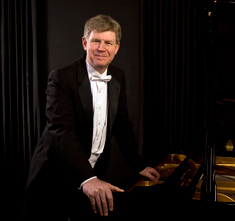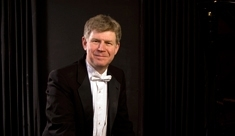 Some people are winners. Some people know how to take on a task and to thoroughly complete it. They are steadfast, hardworking, and brilliant at whatever they attempt, because they only attempt success. That’s it. Winning is what they do. Ian Hobson is that kind of person, and I’ve been fortunate enough to see him in action as a conductor and a soloist.
Some people are winners. Some people know how to take on a task and to thoroughly complete it. They are steadfast, hardworking, and brilliant at whatever they attempt, because they only attempt success. That’s it. Winning is what they do. Ian Hobson is that kind of person, and I’ve been fortunate enough to see him in action as a conductor and a soloist.
Ian Hobson was the conductor when I heard Sinfonia da Camera at The Krannert Center for the Performing Arts several weeks ago. They were great. That night’s program outlined Hobson’s international career, describing his work with Chopin’s pieces and the many ensembles with which he’s worked. (Great Britain’s Royal Philharmonic Orchestra, The London Philharmonic Orchestra, and Moscow Chopin Orchestra, to name just a few. He is also an opera conductor.) I knew then that this would not be the last time I heard his name or saw his hand in a performance. Then I heard about Hobson’s Complete Solo and Chamber Music for Piano of Johannes Brahms.
I knew that this presentation of Brahms was going to be something special. I know now that, when I see Ian Hobson play, whatever the music selection, it will be something he has mastered. (Hobson is one of the youngest graduates of London’s Royal Academy of Music. He clearly does not mess about.) He was the first artist to record all of Chopin’s canon, and, in 2011–12, Hobson presented Robert Schumann’s entire solo piano works in Urbana, Illinois. When this man fixates on a project, he does it with a thoroughness that goes beyond impressive.
At Smith Memorial Hall, on the UIUC campus, Hobson described his impending performance piece, Fantasien, Op. 116 and Sechs Klavierstücke, Op. 118, by Johannes Brahms. He admits that he is “not exactly sure why so many students choose [Sechs] for their debut recital.” He described each movement, and I was excited to hear this “almost palindromic” suite with the intermezzo “centerpiece.” After his brief lecture, Hobson sat down and almost immediately began to play.
Hobson is all business on the piano bench. In fact, he looks like he is crunching numbers as he plays, his face almost a mask. All of the passion shows in his hands and, by extension, his arms. Any artistic expression is shown in these extremities. I saw no painful wincing, deep sighs, or the heavy swaying of an entranced player. He is a businessman in his torso and face, an artist in his hands.
The first movement was over before I knew it. I admit I was distracted by a woman who seemed to almost purposefully open her candy too loudly over far too long a period of time. It would have been comical if it hadn’t been so enraging. She whispered (if you can even call it that) from across the way, and I was stunned by her inconsiderate behavior. I don’t know if it’s an intimate setting that invites this kind of living room mentality, or if the close quarters make it more apparent. I expected to turn around to get an eyeful of a young student, oblivious to her surroundings (as are most people who live with headphones glued to their heads). I was shocked to see a woman who was old enough to pass these bad habits along to great-grandchildren. It just goes to show that rudeness knows no age.
When I forced my rage-brain back to Ian Hobson’s performance, I was treated to a gentle cascade of notes. The longing and romance in this torrent of music is palpable. Hobson’s hands press and lift aching chords from the keys, the sound of the piece flowing seamlessly from emotion to emotion. The fourth movement is hesitant, sad, and wistful. There is a parenthetical push of his glasses, a part of the piece. He moves in to the fifth movement and, poof, it’s over.
The offensive cellophane wrapper in this portion of the recital may have caused a time warp. I was yanked, again, from the skill of the musician and forced to bite my tongue. I had nothing else in mind the entire time she fumbled with that damn candy, again, for a comical/enraging amount of time.
The sixth and seventh movements were my favorite. The dynamics are especially apparent in the sixth, Intermezzo in E major, as the rolling, bubbling notes fall over one another. The seventh features aggressive, odd punches that add interest and surprise. At one point, moving up the scale, Hobson’s hands actually trail off the side of the piano gracefully, as if he’s just run out of keyboard. He would keep going, but the piano won’t allow it…
Sechs Klavierstücke begins with a lift … pause … and hard punctuation. Hobson’s patience and artistry are delightful. There is a swelling sweetness to the first movement, and this soloist knows how to coax it to full realization. As the second and third movements were revealed, I heard angry, passionate arguments, halting and building until the final resignation. Again, Hobson’s upper body remains eerily still while his facial expressions are minimal, if not imperceptible. The emotions are shooting through and being absorbed by his hands.
Hobson knows how to milk these pieces for their full worth. He glides through a swirl of notes; he crosses one hand delicately over another to touch the other side, like a toe testing cold water. Hobson is a patient man. It is well worth the time and money to see him in action. He’ll be playing at Smith Memorial Hall again on April 17 and again on the 26th. You can, and should, get tickets through The Krannert Center for the Performing Arts.
On April 17, Hobson will be playing piano for Sonata No. 3 in D Minor with violinist Andrés Cárdenes, Csaba Erdélyi on viola, and cellist Ko Iwasaki. They will also present Piano Quartet No. 3 in C Minor for Piano, Violin, Viola, and Cello, Op. 60.
On April 26, Hobson will play with David Harris on clarinet and Dmitry Kouzov on cello. They will perform Trio for Clarinet, Cello, and Piano in A Minor, Op. 114; Sonata No. 1 in E Minor for Cello and Piano, Op. 38; Sonata No. 2 in F Major for Cello and Piano, Op. 99; Four Pieces for Piano, Op. 119.








